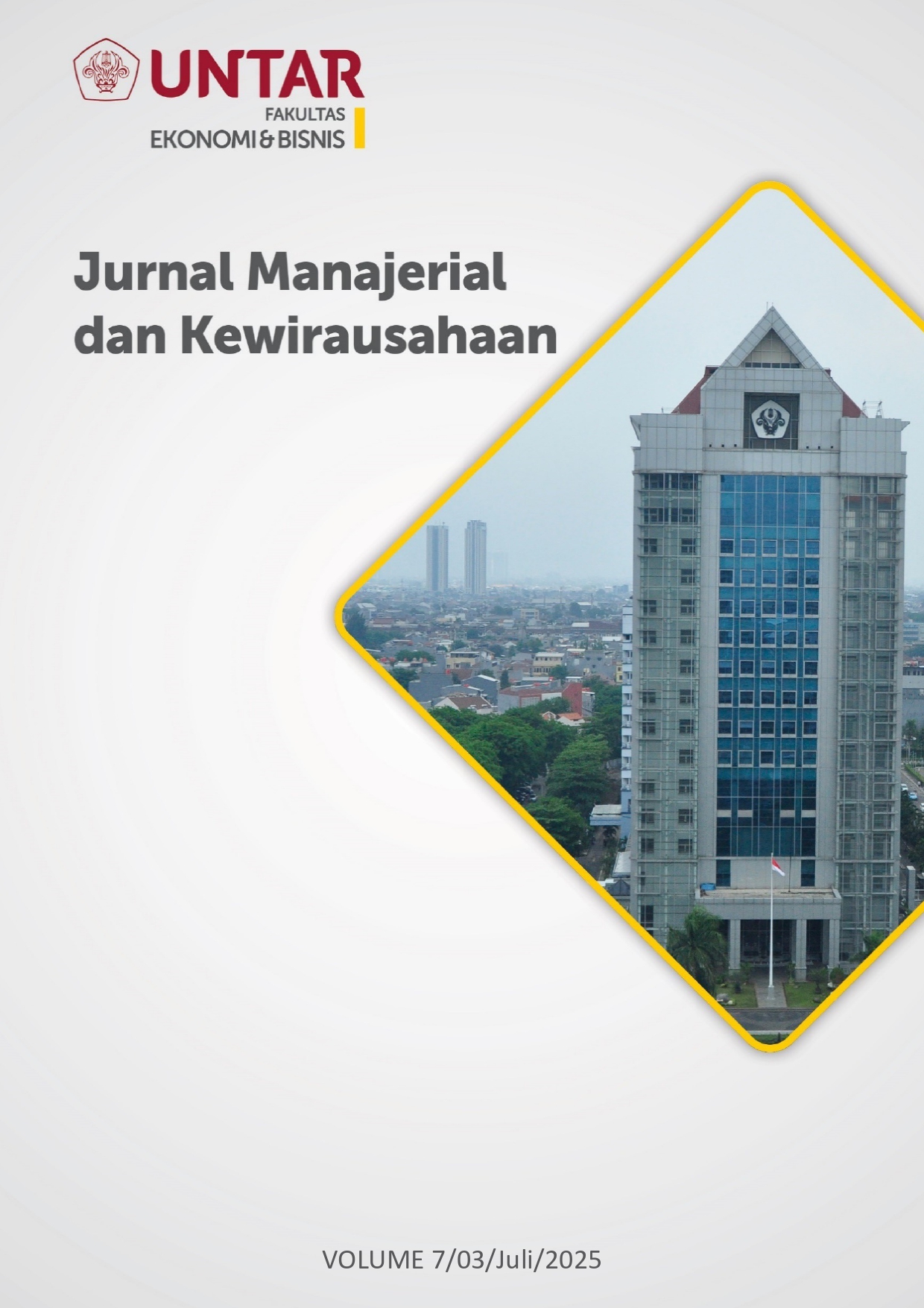Analisis Pengaruh Organizational Commitment dan Work Motivation terhadap Employee Performance PT Breadseason Boga Rasa
Main Article Content
Abstract
Tujuan dari penelitian ini adalah untuk menguji pengaruh organizational commitment dan work motivation terhadap employee performance PT Breadseason Boga Rasa. Employee performance merupakan aset yang penting bagi perusahaan, hal ini dikarenakan karyawan merupakan kunci sukses bagi setiap perusahaan maka dari itu, setiap perusahaan bergantung pada employee performance mereka. Penelitian ini menggunakan metode non-probability sampling dengan jumlah sampel yang diperoleh yaitu sebanyak 46 responden dari karyawan PT Breadseason Boga Rasa dan pengolahan data dilakukan menggunakan software Smart-PLS. Hasil penelitian menunjukkan bahwa organizational commitment memiliki pengaruh yang signifikan terhadap employee performance. Work motivation juga memiliki pengaruh yang signifikan terhadap employee performance.
The purpose of this study is to examine the effect of organizational commitment and work motivation on employee performance at PT Breadseason Boga Rasa. Employee performance is an important asset for a company, this is because employees are the key to success for every company, therefore, every company depends on their employee performance. This study uses a non-probability sampling method with a sample size of 46 respondents from PT Breadseason Boga Rasa employees and data processing is carried out using Smart-PLS software. The results of the study indicate that organizational commitment has a significant effect on employee performance. Work motivation also has a significant effect on employee performance.
Article Details

This work is licensed under a Creative Commons Attribution-NonCommercial-ShareAlike 4.0 International License.
This work is licensed under a Jurnal Muara Ilmu Ekonomi dan Bisnis Creative Commons Attribution-ShareAlike 4.0 International License.,/p>
References
Becker, G. S. (1964). Human capital: A theoretical and empirical analysis with special reference to education, 1st edition. NBER.
Becker, H. S. (1960). Notes on the concept of commitment. American Journal of Sociology, 66, 32−42. http://dx.doi.org/10.1086/222820
Guay, F., Vallerand, R. J., & Blanchard, C. (2000). On the assessment of situational intrinsic and extrinsic motivation: The Situational Motivation Scale (SIMS). Motivation and Emotion, 24(3), 175-213. http://dx.doi.org/10.1023/A:1005614228250
Kuswati, Y. (2020). The effect of motivation on employee performance. Budapest International Research and Critics Institute-Journal, 3(2), 995-1002.
Masman, R. R., & Pamungkas, A. P. (2013). Analisis pengaruh kepemimpinan transformasional, kepemimpinan transaksional dan motivasi terhadap kepuasan kerja. Jurnal Manajemen, 17(1), 94-107.
Millenia, S., & Masman, R. R. (2022). Pengaruh work-life balance terhadap organizational commitment dimediasi oleh job satisfaction. Jurnal Manajerial dan Kewirausahaan, 6(1), 108-116. https://doi.org/10.24912/jmk.v6i1.28577
Mowday, R., Steers, R. M., & Porter, L. (1979). The measurement of organizational commitment. Journal of Vocational Behavior, 14, 224-247.
Nonaka, I. (1994). A Dynamic Theory of Organizational Knowledge Creation. In Knowledge, Groupware and the Internet (Vol. 5, Issue 1). Butterworth-Heinemann. https://doi.org/10.1016/B978-0-7506-7111-8.50003-2
Nugraha, R. N., & Sarinah, L. (2024). The Effect of Work Motivation and Reward System on Employee Performance at Travel Agent: Case Study Travelinn. West Science Social and Humanities Studies, 2(04), 650-657.
Pfeffer, J. (1994), Competitive Advantage Throught People: Unleashing The Power of The Work Force, Harvard Business School Press, Boston, MA.
Porter, L. W., Crampon, W. J., & Smith, F. J. (1976). Organizational commitment and managerial turnover: A longitudinal study. Organizational behavior and human performance, 15(1), 87-98.
Rita, M., Randa Payangan, O., Rante, Y., Tuhumena, R., & Erari, A. (2018). Moderating effect of organizational citizenship behavior on the effect of organizational commitment, transformational leadership and work motivation on employee performance. International Journal of Law and Management, 60(4), 953-964.
Shmailan, A. S. B. (2016), The relationship between job satisfaction, job performance and employee engagement: An explorative study. Issues in Business Management and Economics, 4(1), 1-8.
Soomro, B. A., & Shah, N. (2019). Determining the impact of entrepreneurial orientation and organizational culture on job satisfaction, organizational commitment, and employee’s performance. South Asian Journal of Business Studies, 8(3), 266-282.
Sugiyono, D. (2013). Metode penelitian pendidikan pendekatan kuantitatif, kualitatif dan R&D.
Sugiyono. (2015). Metode Penelitian Kombinasi (Mix Methods). Bandung: Alfabeta.
Vroom, V. (1964). Expectancy Theory – Victor Vroom ; 1964 ( Process Theory )
Vroom, V., Porter, L., & Lawler, E. (2015). Expectancy theories. In Organizational Behavior 1 (pp. 94-113). Routledge.



